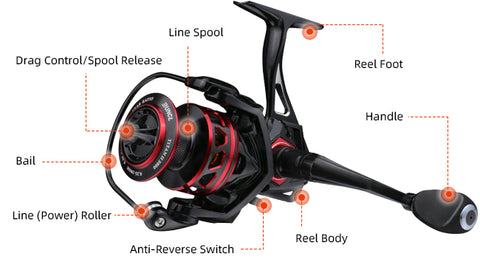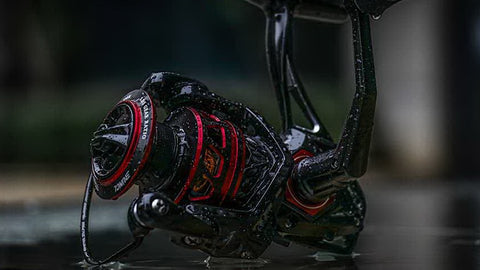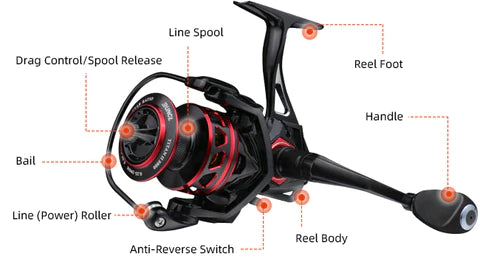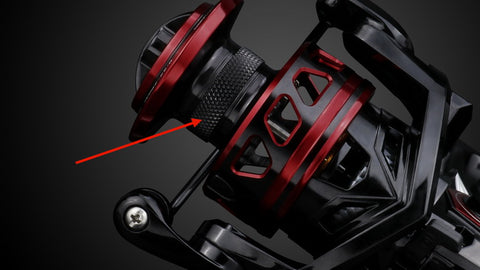Spinning reels are an easy-to-use, and open-face reel with a visible spool that attaches to the underside of a spinning rod. Compared with the casting reels, spinning reels are more suitable to be introduced to amateur anglers because they are less likely to get tangles in the fishing line.
Spinning Reel Parts
The spinning reel has 8 main parts, and each is a functional consideration that you will choose based on your personal wants.

1. Reel Foot
Reel foot is what to be attached to a fishing rod.
2. Handle
Most handles of this type of reel is reversible. For exsample, you can easily change the Titan II spinning reel to a left-hand or right-hand specific to fit your needs by rotating the screw. Rotating the handle turns the spool and bail while retrieving the fishing line. Therefore you will not see spinning reels labeled as “right-handed” or “left-handed”.
3. Reel Body
The body of a spinning reel is either made of plastic, aluminum, graphite or sometimes a combination. In general, aluminum body spinning reel is stronger than graphite and exhibits less flex; however, graphite is lighter. And plastic spinning reels are more to be designed for children. The highest quality freshwater reels tend have aluminum bodies; however, graphite body is a better choice for saltwater fishing due to its corrosion-resistant qualities.
4. Anti-Reverse Switch
This is a small on/off lever found on the bottom of the reel. By switching the anti-reverse switch “on”, the spool will not go backwards. When it is “off” the opposite is true allowing you to reel in reverse. This is a handy way to adjust tension when you don’t have time to adjust the drag while fighting with a fish.
5. Line Spool
The spool is where the braided, mono, fluorocarbon fishing line actually sits on the reel. The line capacity determines the size and model of the reel. Generally speaking, the less of the line capacity, the smaller the reel will be.
Nowadays, more and more manufacturers are using a 'Braid Ready' spool on their spinning reels. If you have been spooled braide line on a spinning reel, you will find that braid will slip around the spool, and generally, we can use an arbor knot or some other slip knot to avoid. When you have a 'Braid Ready' spool spinning reel means you can tie the braided line directly to the spool without having to use a monofilament backer or knot.
6. Drag Control/Spool Release
A drag system is a braking system inside the reel. It applies friction to slow the spool when hooking and fighting a fish. Spinning reels often come with a drag control on top of the spool to add or remove tension to your fishing line. Otherwise the drag control is at the back of the reel body. Turning the drag knob makes it harder or easier for the reel to rotate.
This is also where you can unscrew the spool to take it off and replace with another spool.
7. Line (Power) Roller
Line roller holds the line in the place as the reel moves up and down during rotation.
8. Bail
The bail serves two essential purposes. For one, it is the casting trigger. To cast your bait, you must open or activate the bail for line to spool off properly. To retrieve or reel in, you must close the bail. To close, turn the handle as if you’re reeling. The automatic closing system should activate. The second function of your spinning reel’s bail is to keep your fishing line in-line as it comes off and rolls onto your spool.

Spinning fishing can be a quality introductory fishing style for beginners. With these tips you can hook into a better understanding of your spinning reel components.
More articles:
Spinning Reel 101 - Guide To Understanding What The Numbers Mean On A Spinning Reel
Spinning Reel 101 - 5 Tips Help You To Choose A Correct Spinning Reel


